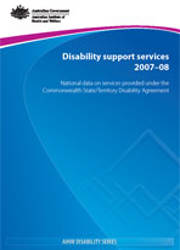Summary
This report presents information about people who used specialist disability services during 2007-08, and the agencies and outlets that provided services. Key trends in service provision are also examined using 5 years of national data collected for the Commonwealth State/Territory Disability Agreement National Minimum Data Set (CSTDA NMDS).
Specialist disability services funded under the CSTDA were targeted at people whose disability manifests before age 65 years, who have substantially reduced capacity in self-care, mobility and/or communication, and a need for ongoing or long-term episodic support. Many people in this CSTDA target population also receive support services through other disability programs, in addition to accessing generic services that exist for the benefit all Australians. The picture presented in this report needs to be considered in that broader service system context.
Increase in service users and expenditure
Almost one quarter of a million (245,746) people used CSTDA-funded services in 2007-08. The number of service users across all service groups increased by 31% between 2003-04 and 2007-08 (7% average annual growth). Respite and employment services registered the highest increases, 53% and 40% respectively, in service users between 2003-04 and 2007-08 (Section 2.1). Over the same period, total government expenditure on specialist disability services increased by 22% in real terms. Each of the five main service groups: accommodation support, community support, community access, respite and employment; registered real increases in total expenditure (Section 1.3).
Respite services used by more people, but less spent on each
CSTDA-funded respite services also registered the highest growth in service users relative to target population. In 2007-08, some 31,500 people used CSTDA-funded respite services compared with 20,500 in 2003-04, corresponding to an increase from 96 respite users per 1,000 target population in 2003-04 to 137 per 1,000 in 2007-08. Over the same period, government expenditure per respite service user fell by 16% in real terms (Section 1.3). Available data on hours of respite received show a downward trend from an average of 12.1 per respite user per week in 2003-04 to 10.5 hours per week in 2007-08 (Table 6.5). Data improvements are needed for a clearer picture of trends in CSTDA-funded respite service provision and service quantity measures more generally.
More service providers
Close to 11,000 outlets delivered CSTDA-funded services in 2007-08; an increase of almost one-quarter since 2003-04 (Chapter 5). This is a largely non-government services sector: specialist disability employment services were provided almost entirely by non-government organisations and three-quarters of people who received state and territory-delivered services accessed those services through non-government organisations (Section 2.1).
Service user characteristics
Intellectual disability continues as the predominant primary disability, accounting for around one-third of service users in 2007-08 (Section 2.2). The data reveal an ageing service user population of growing cultural diversity (Chapters 2 and 4; Chapter 4 is a special focus chapter on Aboriginal and Torres Strait Islander service users), with a strong presence of informal carers, mainly mothers, of people with disability accessing the specialist disability service system (Chapter 3).



